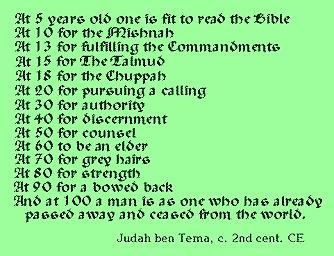LIFETIME EVENTS
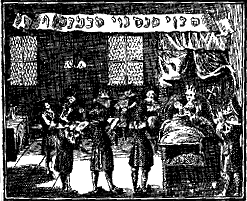 |
For explanation, see text on left. |
Kirchner's illustration on the right shows that in Germany in the 18th century, it was still the custom to place a banner over the mothers bed from child birth to the circumcision with an incantation written on it. This one says Sanui, Sansanui, Samangaluf (the names of angels thought to protect the mother and infant from Lilith, the first wife of Adam.) Thankfully, this superstition appears to have almost died out. But as recently as five years ago a young mother told me that her mother-in-law had insisted that red ribbons should be hung in the room where she was giving birth. These red ribbons may be linked to those now being touted at the Western Wall in Jerusalem.
In Biblical times the mother was regarded as being ritually unclean for a period of time after the birth, when she was not permitted to go into a holy place.1. It mentions a short period of tom'a (impurity) and a longer period of d'mey tohorah (blood of her uncleanliness) at the end of this time she went to the Temple and offered a burnt offering and a sin offering. Talmudic Rabbis offered a very lame explanation for the sin offering saying that during her labour pains the women vowed never again to have intercourse with her husband and afterwards repented of the vow, and so had to make a sin offering.2. Probably the perceived uncleanness was due to the bodily fluids of the birth process and her case was parallel to a man who had an issue from his flesh 3. who also had to make sin offering. This objectionable concept of child birth has been largely rejected, but even the sin offering was probably not quite so regrettable as the fact that in Biblical times a mother had to spend twice as long in purification for a daughter as for a son.4. This clearly is not the modern Jewish view either of children or of motherhood.
God told humans Be fruitful and multiply5. It is therefore a  mitsvah (commandment) to have children. One had fulfilled that duty by having at least two, a boy and a girl. Apart from that we are participating in the creation of life, contributing to the process of evolution, and preserving human life on earth. The birth of a new baby is a truly wondrous event. (see also BABY BLESSING.
mitsvah (commandment) to have children. One had fulfilled that duty by having at least two, a boy and a girl. Apart from that we are participating in the creation of life, contributing to the process of evolution, and preserving human life on earth. The birth of a new baby is a truly wondrous event. (see also BABY BLESSING.
(1.) Lev. 12, 2-5. (2.) Nid. 31b. (3.) Lev. 15. 2 & 15. (4.) Lev. 12, 2 - 5. (5.) Gen. 1, 28.
CIRCUMCISION.
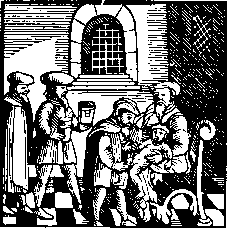 |
| Circumcision. Amsterdam, 1662. |
The Bible states that circumcision dates back to the first Jew (Abraham), who was told by God: This is my covenant, which you shall keep, between me and you and your seed after you; Every male child among you shall be circumcised.. And you shall circumcise the flesh of your foreskin; and it shall be a sign of the covenant between me and you. And he who is eight days old shall be circumcised among you, every male child in your generations.6. Circumcision is therefore known as  Brit Milah (the Covenant of Circumcision.) This often shortened down to Brit, or as Ashkenazi Jews say Briss. The ceremony usually takes place, as the Bible states, on the eighth day. There is a popular misconception that circumcision is a sacrament that makes the child a Jew, in the same way that Christening makes a baby a Christian. In Judaism, circumcision is a mitsvah (a commandment) and is a sign that the child is a Jew, who is in a covenant relationship with God. Providing that he has the required Jewish parentage, he was a Jew from the moment that he was born. If Jewish parents do not have their son circumcised then a
Brit Milah (the Covenant of Circumcision.) This often shortened down to Brit, or as Ashkenazi Jews say Briss. The ceremony usually takes place, as the Bible states, on the eighth day. There is a popular misconception that circumcision is a sacrament that makes the child a Jew, in the same way that Christening makes a baby a Christian. In Judaism, circumcision is a mitsvah (a commandment) and is a sign that the child is a Jew, who is in a covenant relationship with God. Providing that he has the required Jewish parentage, he was a Jew from the moment that he was born. If Jewish parents do not have their son circumcised then a  Bet Din (Rabbinical court) should do so; but even if it is not done, he is still a Jew, but one over whom a required commandment has not been carried out. At the age of 13 if it still has not been done, then it is the boy's responsibility to have himself circumcised.7.
Bet Din (Rabbinical court) should do so; but even if it is not done, he is still a Jew, but one over whom a required commandment has not been carried out. At the age of 13 if it still has not been done, then it is the boy's responsibility to have himself circumcised.7.
(6.) Gen. 17, 10-12. (7.) Kid. 29a.
COVENANT OR SIGN?
The Genesis passage speaks of circumcision both as a covenant and as the sign of a covenant. In Biblical times it was usual to give or exchange a token as a tangible sign that a covenant had been agreed. So the covenant with Noah had a rainbow as the sign.8. It seems probable that circumcision was the sign which served as a reminder of the covenant that God made with Abraham's descendants, for the Bible states: I will establish my covenant between me and you and your seed after you in their generations for an everlasting covenant, to be a God to you. And I will give to you, and to your seed after you, the land where you are a stranger, all the land of Canaan, for an everlasting possession; and I will be their God 9. This was expressed more clearly to Moses and Jeremiah as I will be your God, if you will be My people.10. The covenant therefore means we are to be a holy people living in a holy land and obeying God's commands, and in return He will be our God.
(8.) Gen. 9, 8-17. (9.) Gen. 17, 7-8. (10.) Ex. 6, 5-7 & Jer. 31, 32.
HISTORY OF CIRCUMCISION.
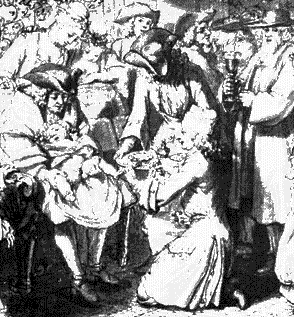 |
Circumcision may well predate Abraham. The fact that at first flint knives were used 11. seems to imply that it went back to Neolithic times. After Abraham introduced the custom for himself and his family, there were times when circumcision was not observed. So Moses did not circumcise his sons and his wife Zipporah had to carry out emergency operations.12. While all the Jews who came out of Egypt were circumcised, those born in the desert were not. So Joshua arranged for a mass circumcision at a place known as the Gibe'at Ha-arelot, (the Hill of Foreskins.)13. It is interesting that like Abraham's covenant this was linked with occupation of Canaan. During the persecutions of Antiochus and the Greeks during the 2nd century BCE, many Jews went uncircumcised. Later, John Hyrcanus embarked a military campaign against the Idumeans and insisted that those who wanted to live in the occupied territories had to be circumcised.14.
The Bible frequently uses the term uncircumcised to refer to a non-Jew. So by the early middle ages, this was the popular way of thinking, despite the fact that a number of other peoples also carry out the practice. It was at this time that circumcision was often performed in the Synagogue. A number of synagogues had a special chair called the chair of Elijah. The Sandek (See CIRCUMCISION CEREMONY.) would sit in this chair, holding the baby. Elijah was associated with circumcision because he came out strongly against those who had forsaken the covenant 15. because of the influence of Queen Jezebel.
In more recent times, circumcision was practised in many non-Jewish families for health reasons. (Dr Spock's advice to mothers favoured the operation.) But later medical opinion has been less favourable, holding the view that it is not wise to subject a baby to "an unnecessary" operation. However if it is not done infancy, about 10% of all males will require it later in life because of non-retractability of the foreskin.16. In that case it is more traumatic for the child and requires a full anaesthetic. There is also medical opinion which holds that the circumcised are less likely to get certain other infections and their partners less likely to suffer from cancer of the cervix.17.
(11.) Joshua 5, 2-3. & Ex. 4, 25. (12.) Ex. 4, 25. (13.) Joshua 5, 2-5. (14.) Josephus:Ant. 13, 9, #1. (15.) 1 Kings, 19, 14. (16.) EJ. Vol 5,. 575. (17.) Ibid.
THE CEREMONY.
The operation is carried out by a trained person, known as a  Mohel (circumciser.) Today he or she 18. is often a qualified doctor. In the Orthodox community they require a
Mohel (circumciser.) Today he or she 18. is often a qualified doctor. In the Orthodox community they require a  Minyan to be present. The father submits his son for the operation and says a blessing. The baby is held on the lap of a respected member of the family, known as the Sandek (Greek for godfather). In some Ashkenazi families they have two 'godparents' known as Kvater and K'vaterin. The Mohel is usually very quick, and the only anaesthetic necessary is usually a drop of wine in the baby's tongue. At eight days, the baby's nervous system is not properly developed, and I have known babies cry more when the nappy was removed than when they were circumcised. The Baby receives a Hebrew name, and a prayer is said that he may grow up in health to stand under a Chuppah. After the ceremony there is usually a family celebration.
Minyan to be present. The father submits his son for the operation and says a blessing. The baby is held on the lap of a respected member of the family, known as the Sandek (Greek for godfather). In some Ashkenazi families they have two 'godparents' known as Kvater and K'vaterin. The Mohel is usually very quick, and the only anaesthetic necessary is usually a drop of wine in the baby's tongue. At eight days, the baby's nervous system is not properly developed, and I have known babies cry more when the nappy was removed than when they were circumcised. The Baby receives a Hebrew name, and a prayer is said that he may grow up in health to stand under a Chuppah. After the ceremony there is usually a family celebration.
(18.) For women being permitted to circumcise see SA Yore De'ah 264, #1.
REASONS FOR CIRCUMCISION.
- BIBLICAL COMMANDMENT. See CIRCUMCISION.
- REMINDER OF THE COVENANT. See COVENANT OR SIGN?
- SIGN OF IDENTIFICATION. To make a distinction between the Jews and the uncircumcised non-Jews. This was not infallible as some other people also practised circumcision.
- HELP TO MORAL BEHAVIOUR. As a reminder that we should follow the sexual code taught in the Bible. And to teach that all aspects of life should be governed by religious teaching.
- HEALTH REASONS. This was suggested by Philo, but not by other authorities until recent times. It is thought to reduce the incidence of cancer of the penis and also cancer of the cervix in women together with the reduction of lesser genital problems.19.
- REPLACEMENT OF CHILD SACRIFICE. It is probably no coincidence that circumcision and the forbidding of child sacrifice (Akedah story)20. were both attributed to the time of Abraham. There is archaeological evidence that children were sacrificed by peoples living in the middle east in early times. Some people apparently thought it right to offer the baby back in thanks to God for the fruit of their bodies as well as the fruit of trees or the produce of the land. It is likely that circumcision was giving back to God a portion of the newly-born child as a thank offering instead of sacrificing the whole child.
(19.) EJ vol 5, 578. (20.) Gen. 22.
PIDYON HABEN.
 Pidyon Haben, The Redemption of the first-born is of Biblical origin. Originally, the oldest son in the family inherited the birthright, which included the religious leadership in the family and the community.21. This remained the situation until the episode of the golden calf.22. On this occasion, the religious leaders obviously failed in their duty to prevent the people from worshipping of an idol. From then on, the tribe of Levi became the religious leaders and part of that tribe, the descendants of Aaron, became Cohanim (priests). The Bible narrates how they counted the number of first-born sons over the age of a month and the number of Levites.23. They swapped them over, but there were more first-born sons than Levites, so these extra Levites had to redeem themselves from their duties by paying 5 shekels.24.
Pidyon Haben, The Redemption of the first-born is of Biblical origin. Originally, the oldest son in the family inherited the birthright, which included the religious leadership in the family and the community.21. This remained the situation until the episode of the golden calf.22. On this occasion, the religious leaders obviously failed in their duty to prevent the people from worshipping of an idol. From then on, the tribe of Levi became the religious leaders and part of that tribe, the descendants of Aaron, became Cohanim (priests). The Bible narrates how they counted the number of first-born sons over the age of a month and the number of Levites.23. They swapped them over, but there were more first-born sons than Levites, so these extra Levites had to redeem themselves from their duties by paying 5 shekels.24.
From then on every first-born son of a Jewish woman had to be redeemed from the responsibility of the priesthood by paying an equivalent sum to a Cohen (priest descended from Aaron). This little ceremony is called Pidyon Haben and takes place when the baby is a month old.
Many Jews see little or no point in preserving the distinction between priests and other Jews. Firstly, because the Torah describes all Jews as a kingdom of priests and a holy people.25. Secondly, as the purpose of keeping the priests separate was in order that eventually they would be able to carry out their original duties of making the sacrifices in a rebuilt temple in Jerusalem. Only a very few ultra-Orthodox Jews want to see animal sacrifices restarted. For these reasons, Reform and Liberal Jews do not practise Pidyon Haben. There is a third objection raised by some Cohanim. They feel that they might be accepting money under false pretences. There are very strict rules for priestly descent,26. and if just one of their ancestors had failed to fulfil these requirements, then their claim to being a Cohen would be invalid. Some of them solve the problem by participating and donating the redemption money to charity, others refuse to take any part in it at all.
(21.) Ex. 13, 2. (22.) Ex. Ch. 32. (23.) Num. Ch.3. (24.) Num. 18, 15-16. (25.) Ex. 19, 6. (26.) Lev. 21, 13-14.
CHILDRENS NAMES.

Jewish children are usually given at least two names one secular (in the vernacular) and one a Hebrew name. This custom was practised as early as the 4th century BCE. We find examples in the later books of the Bible 27. and in the Apocrypha.28. Today we often find that the names given begin with the same letter. The names given tended to be:
- The first two sons were named after the two grandfathers.29.
- The first two daughters were named after the two grandmothers.
- The remaining children after other members of the family.
(27.) Daniel 1, 7 & Esther 2, 7. (28.) 1 Maccabees 2, 2-3. (29.) Ben. Rabba 37, 7. The descendants of Hillel did this for about 12 generations.
BABY BLESSING.
The problem with both Circumcision and Pidyon Haben is that each is only for male babies. There is no equivalent celebration for girls. When a girl is born, the father is called up to the reading of the scroll in Synagogue, and the name of the baby is announced; but even this leaves out the mother. It was therefore felt that some ceremony involving both parents should take place. In 1880, Dr Nathan Marcus Adler, then English Chief Rabbi, put together a short service and this was included in Singer's Prayer Book (Orthodox) under the heading Thanksgiving For Childbirth.30. There had been a ceremony in Germany in the late 15th century which took place when the mother went to Synagogue and the baby girl's name was sometimes mentioned.31. Adler's service seems to have been the first recognition for such a service in recent times. Since then, a number of Liberal and Reform prayer books have included such services. These contain the following elements:
- The parents giving thanks for the birth of the new baby.
- The child is publicly named.
- A blessing is said over the child.
- The parents recognise their responsibility to give the child a Jewish upbringing.
(30.) Singers, p. 312. (31.) Israel Abrahams: Commentary to Singer's Prayer Book, p. ccxxiii.
EDUCATION.

Judaism lays much emphasis on the responsibility of parents to teach their children about their heritage. The  Sh'ma the most significant prayer states these words which I command you today, …. You shall teach them carefully to your children.32. It is not clear whether the words referred to are just the belief in One God, the Ten Commandments (listed in the previous chapter) or the whole of the Torah. The Talmud lists parental duties in these words: The father is bound in respect of his son, to circumcise, redeem him (if the first-born), teach him Torah, take a wife for him, and teach him a craft. Some say, to teach him to swim too, R. Judah said: He who does not teach his son a craft, teaches him brigandage.33.
Sh'ma the most significant prayer states these words which I command you today, …. You shall teach them carefully to your children.32. It is not clear whether the words referred to are just the belief in One God, the Ten Commandments (listed in the previous chapter) or the whole of the Torah. The Talmud lists parental duties in these words: The father is bound in respect of his son, to circumcise, redeem him (if the first-born), teach him Torah, take a wife for him, and teach him a craft. Some say, to teach him to swim too, R. Judah said: He who does not teach his son a craft, teaches him brigandage.33.
 |
During the middle ages, the custom began of entrusting religious education to specialised school teachers. The primary school was known as the Cheder (literally the room) and the secondary education was known as the Y'shivah (sitting.) The name Cheder arose because a special room in the synagogue building was set aside for religious teaching. A synagogue is still referred to by many Jews as the shule (school). The synagogue's religion classes are often still called the Cheder. The term y'shivah, was used in Talmudic times to refer to a Rabbinic academy. Older students still attend y'shivot (plural) to study the Talmud.
Some Jewish parents believe that they have fulfilled their religious obligations by ensuring that their children have attended Religion School. However, Judaism has always stressed that parents have a personal responsibility to pass on their religion. With regards Passover, the Torah mentions this duty at least four times.34. It is often stated that example is the best form of education, and that religion is experienced and caught rather than taught.
(32.) Deut. 6, 6-7. (33.) Kid. 29a. (34.) Ex. 12, 26-7; Ex. 13, 8; Ex.13, 14 & Deut. 6, 20.
BARMITZVAH.

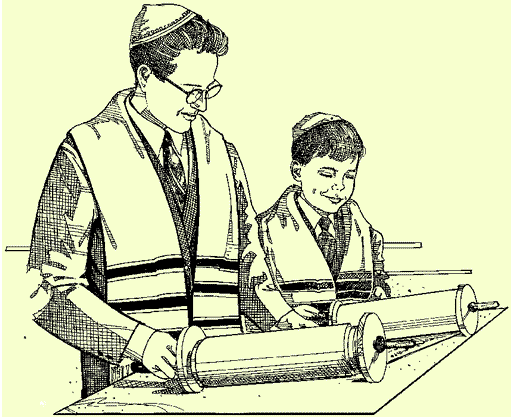
 Barmitzvah, Son of Commandment. Or more precisely a boy ready to carry out the commandments. As the quotation from the Mishnah shows, boys were thought to be adult enough at thirteen to be held responsible for carrying out the various ritual and ethical commandments. At that time there was no special ceremony to mark their change in legal status. Some time about the 15th century CE, a ceremony was introduced. The central part of which was the boy showing he was old enough to be called to the Torah, and read a portion from it. Up to the age of thirteen, the father is responsible for seeing that his son observes the commandments, so there is a quaint custom of the father saying a prayer which thanks God for relieving him of the responsibility for his son.35. This is rather strange, for today, teenage sons are often an even greater responsibility than those who are younger.
Barmitzvah, Son of Commandment. Or more precisely a boy ready to carry out the commandments. As the quotation from the Mishnah shows, boys were thought to be adult enough at thirteen to be held responsible for carrying out the various ritual and ethical commandments. At that time there was no special ceremony to mark their change in legal status. Some time about the 15th century CE, a ceremony was introduced. The central part of which was the boy showing he was old enough to be called to the Torah, and read a portion from it. Up to the age of thirteen, the father is responsible for seeing that his son observes the commandments, so there is a quaint custom of the father saying a prayer which thanks God for relieving him of the responsibility for his son.35. This is rather strange, for today, teenage sons are often an even greater responsibility than those who are younger.
See Also CONFIRMATION.
(35.) Singers, p. 148.
BATMITZVAH.
 Batmitzvah, Daughter of Commandment can never be seen as identical to BARMITZVAH. in Orthodox Judaism.
Batmitzvah, Daughter of Commandment can never be seen as identical to BARMITZVAH. in Orthodox Judaism.
- Firstly the legal age of majority for girls is twelve.
- Secondly, the number of commandments which a girl must obey is far less.
Instead of Batmitzvah, some Orthodox Synagogues have in recent years introduced a service of  Bat Chayil, A Girl of Worth, linked with the verse in Proverbs which speaks of a Woman of Worth 37. This ceremony is often one for a group of girls, who often read various passages from the balcony of the synagogue, and the ceremony takes place on a day other than the Sabbath. The practice is far from uniform in Orthodox Synagogues, some letting the girls read more and others have no such ceremony.
Bat Chayil, A Girl of Worth, linked with the verse in Proverbs which speaks of a Woman of Worth 37. This ceremony is often one for a group of girls, who often read various passages from the balcony of the synagogue, and the ceremony takes place on a day other than the Sabbath. The practice is far from uniform in Orthodox Synagogues, some letting the girls read more and others have no such ceremony.
In Reform and Liberal synagogues girls are encouraged to play an equal part to boys and read a portion from the Torah, but sadly girls do not always want to do so.
See Also CONFIRMATION.
(36.) Meg. 23a. (37.) Prov. 31, 10.
CONFIRMATION.
Some Liberal and Reform Synagogues hold services for 15 or 16 year olds at which they express their commitment for Judaism. These ceremonies were sometimes referred to as Confirmation but are now often spoken of by a Hebrew name such as  Kabbalat Mitzvah (Acceptance of Commandment),
Kabbalat Mitzvah (Acceptance of Commandment),  Ben Torah or
Ben Torah or  Bat Torah (son or daughter of the Torah). The name Confirmation was an unfortunate choice, as it was the same as the term used by Christians to describe the ceremony when young Christians confirm the promises made on their behalf by their godparents at their christening. In Judaism there were no such promises to confirm. Instead the young people are publicly affirming their commitment to Judaism and it's teachings.
Bat Torah (son or daughter of the Torah). The name Confirmation was an unfortunate choice, as it was the same as the term used by Christians to describe the ceremony when young Christians confirm the promises made on their behalf by their godparents at their christening. In Judaism there were no such promises to confirm. Instead the young people are publicly affirming their commitment to Judaism and it's teachings.
From the beginnings of the Reform Judaism in Germany, it was felt necessary to modernise Barmitzvah. The practice had certain drawbacks:
- It only concerned boys and there was nothing equivalent for girls. As a result, girls were seldom given a Jewish education.
- As most boys stopped their Jewish studies at Barmitzvah, it meant that they went through life with a 12-year-olds knowledge of Judaism.
- The emphasis on reading from the scroll often meant that the boy learnt his portion like a parrot.
The earliest proposal to hold Confirmation was probably at the Hamburg Temple in 1817,38. or it may have been carried out first at Breslau by Isaac Asher Francolm, who was conducting such services for both boys and girls some time before 1826. 39. At the earliest services the children were aged 13 and had to answer questions about their commitment. They had to learn these answers by heart like a Catechism. Soon the format was changed to being a group of young people conducting a large part of the service and often also giving a D'var Torah, (Exposition on Torah.) The great advantage of having a ceremony at a later age is the extra two or three years of study and the opportunity to deal with more adult matters.
(38.) Plaut: Rise of Reform Judaism, p. 32. (39.) JE, vol. 5, p. 475 & Plaut: op. cit.. p. 173 f.
MARRIAGE.

WEDDINGS.
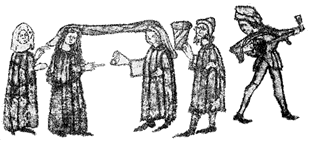 |
Chuppah but with musical accompaniment. |
Jewish marriage customs have varied both from age to age and from place to place. Originally parents arranged marriages for their children. So Abraham sent his servant to find a wife for Isaac and the marriage was arranged by negotiations with Rebekah's family.40. But even in this first biblical account of a marriage, Rebekah was asked if she agreed with the arrangement.41. At this period the groom's parents paid a sum of money, called the Mohar, to the brides family as compensation for the loss of a working daughter.42. It seems almost as if the girl was bought from her parents. Later, the parents used to pass the money on to their daughter. Still later, the money passed from the bride's parents to the groom's in the form of a dowry. Today, arranged marriages only take place among the most Orthodox of Jews. Most young Jews choose their own partners, although some may meet them by going to Jewish dating agencies.
(40.) Gen. 24, 4. (41.) Gen. 24, 57-8. (42.) Gen. 24, 53.
CHANGES IN WEDDING CUSTOMS.
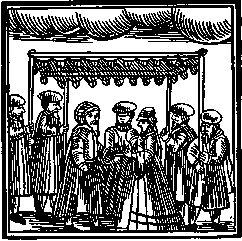 |
For many centuries, marriage was a two-stage process. The first was the ceremony of  Kiddushin (literally Holy Things) Betrothal, when the two families agreed upon the union with all it's financial arrangements. A written contract, called a
Kiddushin (literally Holy Things) Betrothal, when the two families agreed upon the union with all it's financial arrangements. A written contract, called a  Ketubah, was drawn up and signed. At this ceremony a ring or something of value was passed over as a sign that the contract had been made. But the bride remained in her parents' home. She was considered as married and was not permitted to marry anyone else without first getting a divorce. Some months or even years later there was a second ceremony of
Ketubah, was drawn up and signed. At this ceremony a ring or something of value was passed over as a sign that the contract had been made. But the bride remained in her parents' home. She was considered as married and was not permitted to marry anyone else without first getting a divorce. Some months or even years later there was a second ceremony of  Nissu'in Marriage, following this the bride went to live with her husband and the marriage was consummated.
Nissu'in Marriage, following this the bride went to live with her husband and the marriage was consummated.
Some time about the twelfth century, the two stages were combined into one ceremony. During this period it was often very dangerous for Jews to travel and for the two families to have to meet on two occasions might cause undue risk. Secondly, the situation of the bride was most unfortunate, being considered married but separated from her husband. One can still see evidence these two stages in the present wedding service and this accounts for the fact that the young couple have to drink wine twice during the service.
Since the combination of the two ceremonies, it has become a common practice for couples to announce their engagement and have a secular celebration. Then some months later they have their wedding. In this way they have restored the second stage.
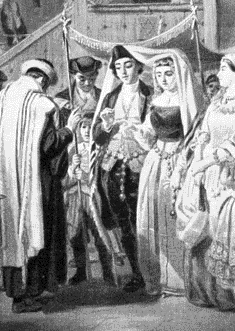 |
under Tallit and hand-held Chuppah. The Couple wear wedding belts. |
CHANGES IN MARRIAGE LAWS.
In Biblical times, although Jews only had one wife, some of the richer males had several wives. For example, Abraham, Jacob, Moses, David and Solomon all married more than one. (Some of these may well have been concubines rather than wives.) The Bible does not forbid polygamy. In Rabbinic times it was rarely practised. The ban on polygamy among Ashkenazi Jews is thought to have been introduced by Rabbi Gershom of Mainz in the 12th century. However Yemenite Jews were still practising polygamy as late as the mid-twentieth century. This was probably because they were living in a predominantly Moslem country.
AUFRUF.
On the Sabbath prior to the wedding it is the custom to call up the prospective bridegroom to the reading of the Torah. This is called by the Yiddish term Aufruf. In those congregations where it is the custom to give women an Aliyah, often the bride is also called up.
BEDEKEN.
In eastern countries it was the custom for married women to be veiled to protect their modesty. Rebekah covered her face when she was about to meet her prospective husband for the first time.43. However, we are also told that Jacob was tricked by Laban into marrying Leah rather than the prettier Rachel.44. Amongst Ashkenazi Jews the custom arose for the bridegroom to be present and participate in the veiling of the bride, and so be sure whom he was going to marry. Hence the Yiddish name which is short for Bedeken di Kale (veiling the Bride). This custom is not carried out by Sephardim and others who no longer regard it as relevant, now that modern veils tend to be less opaque.
(43.) Gen.24, 65. (44.) Gen.29, 23f.
MIKVAH.
It used to be expected of brides that they visit a  mikvah (ritual bath) prior to their marriage. The mikvah was seen as providing ritual purification from menstruation and other forms of "uncleanliness". This is no longer insisted upon by the less orthodox.
mikvah (ritual bath) prior to their marriage. The mikvah was seen as providing ritual purification from menstruation and other forms of "uncleanliness". This is no longer insisted upon by the less orthodox.
CHUPPAH.
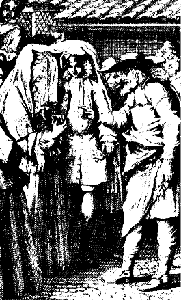 |
Tallit, Amsterdam, 1721, Note the ring finger. |
Jewish weddings today take place under a canopy, which is known as a  Chuppah. The canopy may be set up inside the synagogue, in the synagogue courtyard or in any other suitable location. However by having the wedding in or near the synagogue helps to establish the couple as members of the congregation. The most orthodox of Jews usually hold their weddings in the evening in the open air signifying the hope that their descendants will be as numerous as the stars in the heavens.45.
Chuppah. The canopy may be set up inside the synagogue, in the synagogue courtyard or in any other suitable location. However by having the wedding in or near the synagogue helps to establish the couple as members of the congregation. The most orthodox of Jews usually hold their weddings in the evening in the open air signifying the hope that their descendants will be as numerous as the stars in the heavens.45.
The earliest mention of a Chuppah is in the Bible where it refers to the room where the bridegroom lived.46. This accounts for the present custom of the groom standing under the Chuppah when the service starts and the bride entering a little later to join him there. Marriage customs have varied from place to place and from age to age. In the middle ages the Chuppah almost disappeared from the wedding celebrations and couples were married under a simple cloth, a Tallit or even under the cowl worn by the groom which was taken off and stretched over the couple.47. (see 15th cent. Nuremberg Wedding and the illustration on the right.) In some cases, couples stood under a Tallit which was under a Chuppah (see 19th cent German wedding ) In those communities where young men did not wear a Tallit until they were married, it was usual for the bride to give her future husband a Tallit and it was under this that they were married.
One explanation given is that the Chuppah signifies God's presence which we pray may always be with the couple during their married life.
(45.) Gen. 22, 17. (46.) Psalm 19, 6. (47.) Maharil, Hilchot Nisu'in.
THE RING.
 |
have been dangerous to wear. |
The betrothal takes place when the groom places a ring on the brides finger and says By this ring you are consecrated to me by the law of Moses and Israel. and this is witnessed by two responsible people. Part of this formula dates back at least 1,600 years.47. At this period the groom did not give a ring but something of value like a coin. This was tangible proof that a legal contract had been entered into. In this early form it also confirmed that an act of kinyan (coming from a root meaning buying or purchasing) had taken place. When the wedding ring was introduced in about the 12th century, it become much more of a gift than a purchase. Wedding rings have to be plain metal without jewels so that their value can easily be assessed and the bride not deceived. The old tradition was to place the ring on the index finger of the right hand, as this was the most important finger. Today, many think it more romantic for the ring to be put on the finger on which it will be always worn.
In many Reform and Liberal congregations it is usual for the couple to exchange rings and for each to state publicly their commitment to the other. This finally removes any remnant of the concept of purchase that might still be thought to remain. (See also the wording on the Ketubah.)
(47.) Kiddushin 5b.
WEDDING CONTRACT.
The Jewish wedding certificate is called a  Ketubah, literally meaning a written document.
Use of a written marriage document is long established and the earliest examples still existing were written in a Jewish military outpost in Elephantine in Egypt in the 4th century BCE.48. Originally this was a contract drawn up by the two families when negotiating the marriage. In the more orthodox communities this document still contains some financial clauses which stipulate the husband's responsibilities to the wife if he should ever divorce her. After the wedding the ketubah is given into the bride's keeping as it states her rights and his her proof that she is married.
Ketubah, literally meaning a written document.
Use of a written marriage document is long established and the earliest examples still existing were written in a Jewish military outpost in Elephantine in Egypt in the 4th century BCE.48. Originally this was a contract drawn up by the two families when negotiating the marriage. In the more orthodox communities this document still contains some financial clauses which stipulate the husband's responsibilities to the wife if he should ever divorce her. After the wedding the ketubah is given into the bride's keeping as it states her rights and his her proof that she is married.
In Reform and Liberal congregations great care is taken to avoid any hint of the original concept of the bride being purchased for a possession of the groom. The bride and groom are regarded as equal partners and all undertakings in the document are mutual. (See also The Ring .) For the same reason it is not usual for the bride to walk round her husband seven times at the wedding, as is done in some Ashkenazi Orthodox communities. A second suggested reason for this latter practice is equally unacceptable as it was thought to ward off evil spirits by creating a magic circle.49.
(48.) J.B.Pritchard: Ancient Near Eastern Texts, 222 & 223. (49.)EJ vol 6, 1037.
THE SEVEN BLESSINGS.
In the second part of the service seven blessings are said known as the  (Sheva B'rachot). These are at least 1,500 years old being listed in the Talmud.50. From the times of the Mishnah marriage was referred to as Kiddushin (holy things). The number seven is associated with holiness.
(Sheva B'rachot). These are at least 1,500 years old being listed in the Talmud.50. From the times of the Mishnah marriage was referred to as Kiddushin (holy things). The number seven is associated with holiness.
- The seventh day is the Sabbath,
- Shavuot (Feast of Weeks) comes seven times seven weeks after Pesach,
- The seventh month contains the High Holy Days,
- The seventh year was the year of Sh'mitah (release)51.
- The seven time seventh year led to the Jubilee year.52.
In the popular view seven was thought to be a lucky number. Seven was also the number of times the bride used to walk round the groom. (see previous section)
It is usual to repeat these seven blessings at the end of the grace after meals at the wedding feast.
(50.) Ket.7b & 8a. (51.) Exodus 23, 10f; Deut 15, 12f. (52.) Lev. 25, 8.
BREAKING A GLASS.
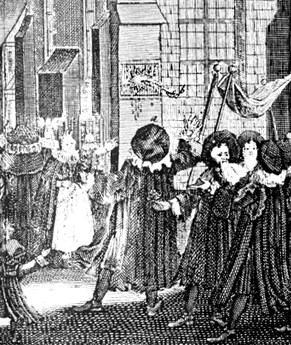 |
of synagogue. Germany, c.1720. |
Probably the most memorable part of the service is when the bridegroom treads on a glass and breaks it. This often follows the drinking of the wine. Over the years many reasons have been given for this custom. Among them are:
- The oldest refers to the Talmudic story of two Rabbis who each broke a glass at a wedding feast when they found that guests began behaving badly.53. They pointed out that a wedding was a serious step in our lives.
- The noise was thought to frighten away evil spirits.54
- As a reminder. The Psalmist says If I forget Jerusalem in chiefest Joy… may my right hand lose it's skill.55. Therefore the broken glass reminds us of the destruction of the Temple. (This explanation was probably introduced deliberately in the 14
th century to replace the previous superstitious reason.)56. - To symbolise the breaking of the hymen.
- To emphasise the seriousness of the vows being given. As if to say If I should break these promises may I be crushed like this glass.
- To prevent any one else from drinking out of it. Emphasising the need to be totally loyal to each other and not to have eyes for anyone else.
It is significant that in times past the glass was not trodden on, but thrown 57. at a special stone on the outer wall of the synagogue known as a traustein (wedding stone) as shown in the illustration. This historical background together with the fact that it is broken immediately after drinking the wine makes it very likely that the sixth is the most probable reason.
When the glass is broken it is usual for those present to say Mazal Tov (good luck) but the original meaning was a favourable constellation of stars. Various Orthodox Rabbis have objected to the custom because instead of creating a serious atmosphere it often results in laughter and chatter.58 They have however been very unsuccessful in their efforts to stop the practice.
(53.) Ber 31a. & Tosafot ad loc. (54.) J.Z.Lauterbach HUCA vol II. (55.) Psalm 137, 6 & 5.(56.) Kol Bo (Laws of Tisha B'Av, 62) & J Z Lauterbach op cit.(57.) Maharil Hilchot Nisu'in. (58.) eg. Hillel Posek: Hillel Omer (Even Haezer 59) & Ben Zion Uziel: Mishp'tey Uziel part II, Even Haezer, p. 431.
DEATH & MOURNING CUSTOMS
| FOR FULL ALPHABETICAL INDEX |
